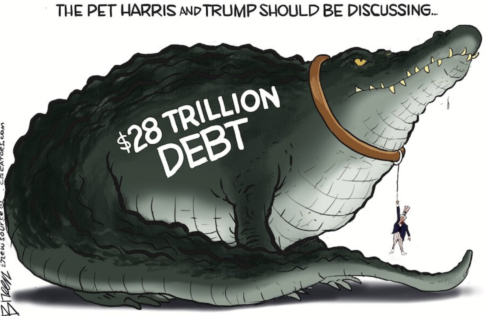The media’s focus on America’s presidential candidates largely centers their positions on high-stakes social issues. Their stances on abortion and immigration are well known, while less sensationalized topics receive far less attention and remain under-discussed. This includes policies that directly impact the everyday lives of all Americans. Donald Trump and Kamala Harris have both proposed policies on the economy that will not only affect the nation’s financial landscape for the next four years but could significantly alter the future of the American economy.
- The Tax Policy
In 2017, Trump signed the Tax Cuts and Jobs Act (TCJA), the largest tax code overhaul since 1986. This legislation permanently reduced the top corporate tax rate from 35% to 21%, but many individual tax benefits are set to expire in 2025. According to the United States House Committee on Ways and Means, if the TCJA is not extended, a typical family of four earning a median income of $75,000 could see a tax increase of approximately $1,500. The potential expiration of the Child Tax Credit will halve its value, and family owned businesses and farms will face burdens by the death tax, potentially forcing asset and land sales.
Trump remains committed to permanentize the tax cuts the 2017 law provided and to lowering tax rates even further. He proposed reducing the corporate tax rate to 15% in early September. By lowering the tax burden on corporations, Trump hopes to incentivize domestic production, increase investment and ultimately create jobs. He has also suggested eliminating taxes on tips, overtime and Social Security, while pushing for the extension of individual tax cuts. Many workers in the service industry rely heavily on tips as a significant portion of their income, and with the potential for higher earnings from overtime, workers may be encouraged to take on more hours. Therefore, there would be increased income for retirees. Trump’s proposed tax reductions aim to stimulate the economy by motivating corporate investment and job creation while providing relief to workers.
Throughout her candidacy, Harris has made it clear that she has middle-class families in mind. Some of her proposals include restoring the Expanded Child Tax Credit, implementing a new $6,000 tax cut to aid new parents and lowering taxes on low-to-moderate income workers. Kamala supports raising taxes on top earners and corporations, specifically raising top corporate taxes to 28%. However, she has promised that no one earning less than $400,000 a year will face increased income tax.
- The Trade Policy
Trump, the self-described “Tariff Man,” and his Vice Presidential pick, Senator JD Vance, are strong proponents for strict tariffs on foreign imports to protect American manufacturers and encourage domestic production. Trump proposed a staggering 10% tariff on all imported goods and a 60% tariff on goods from China in particular. Trump’s rationale is that these measures will fortify the national economy and reduce reliance on foreign imports, aiming to revitalize American industry and secure jobs for U.S. workers. The Republican Party Platform states “The Republican Party stands for a patriotic ‘America First’ Economic Policy. Republicans offer a robust plan to protect American Workers, Farmers, and Industries from unfair Foreign Competition.”
While Harris has not detailed her future tariff proposal, the Biden-Harris administration has previously supported high tariffs on Chinese electric vehicles. She has rejected Trump’s blanket tariff approach, advocating for a more selective application of tariffs rather than broad taxation on all importations. She attempts to support American interests without alienating potential trade partners.
- The Defense Spending Policy
Despite their otherwise differing philosophies, Trump and Harris share a commitment to increasing defense spending.
Trump previously took a very strong stance on increasing defense spending. During his presidency, he constantly pushed for a budget that exceeded inflationary adjustments, prioritizing military readiness and modernization.
Harris agrees that spending should be upped, proposing an $849.8 billion dollar defense budget, which is a $4.1b increase from the 2023 fiscal year. An important distinction between their motivations must be made, however: While Harris is interested in increasing defense spending to account for inflation, Trump has previously raised the budget well beyond what had to be accounted for.
With ongoing wars and heightened global tensions, the candidates recognize the importance of the military to ensure national security.
- The Infrastructure Policy
Both candidates also recognize the importance of infrastructure investment.
Harris played a significant role in supporting the Bipartisan Infrastructure Act, passed in 2021, which aimed to modernize America’s infrastructure through federal investment. This initiative aligns with her broader economic goals of supporting families and communities.
While Trump has expressed strong support for increased infrastructure spending, he did not deliver substantial legislation during his presidency. His promises often center around the idea of improving America’s roads, bridges and public facilities, framing infrastructure investment as a pathway to economic revitalization.
Many of Harris’ policies attempt to benefit families and small businesses, while Trump pushes divesting in international business in an effort to support American industry and the U.S workforce. Voters will need to consider how these policies will shape the future of the American economy and impact their daily lives. Engaging in these discussions is crucial, as the next administration’s choices will have long-lasting implications for the nation’s economic landscape.






